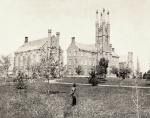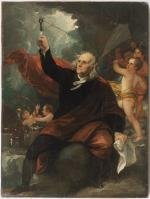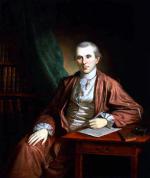Chapter One: The Pillars of Piety and Practical Knowledge: The Growth of Private Education
Religious piety and the pursuit of practical knowledge guided the development of educational institutions in eighteenth-century Pennsylvania. William Penn laid the groundwork for  education in his colony, but also harbored reservations about the
education in his colony, but also harbored reservations about the  education of children in schools. Faithful stewards of Penn's legacy recognized that education was essential to the economic progress and liberty of conscience associated with this "best poor man's country." Whether schooled at home or a church-affiliated academy, colonial Pennsylvanians shared the belief that knowledge tempered by faith and reason best served the ends of personal freedom and the good Commonwealth. Denominational Christianity and a faith-based tradition of learning left an indelible mark on a remarkable network of private educational institutions.
education of children in schools. Faithful stewards of Penn's legacy recognized that education was essential to the economic progress and liberty of conscience associated with this "best poor man's country." Whether schooled at home or a church-affiliated academy, colonial Pennsylvanians shared the belief that knowledge tempered by faith and reason best served the ends of personal freedom and the good Commonwealth. Denominational Christianity and a faith-based tradition of learning left an indelible mark on a remarkable network of private educational institutions.
In the early 1700s, Pennsylvania's colonial leaders gave little serious thought to formal education for the masses. Instead, what developed were schools, academies, and colleges established and governed by the clergy to serve the needs of evangelization and the budding commercial and political elite. In Philadelphia and the agricultural provinces, the religious enthusiasm of the Great Awakening strengthened the role of Protestant denominations in the creation of formal educational institutions. In addition to Quaker elders, Anglican, Moravian, Baptist, Methodist, and Presbyterian ministers exerted significant influence over schools tied to expanding creed and commerce. A century later the emergence of Catholic parochial schools further complicated this rich tapestry of denominational institutions.
William Tennent's Log College in rural Bucks County, which operated between 1727 and 1745, may have been a college in name only, but this backcountry seminary had a profound effect on the Presbyterian Church in America. The Irish-born Tennent drew upon his own training in Scotland to offer would-be ministers a demanding biblically based education that included Theology, Scripture, Greek and Latin, and Homiletics. Log College graduates helped found numerous Presbyterian colleges in the Mid-Atlantic region, including what became Princeton University. A generation later,
Log College in rural Bucks County, which operated between 1727 and 1745, may have been a college in name only, but this backcountry seminary had a profound effect on the Presbyterian Church in America. The Irish-born Tennent drew upon his own training in Scotland to offer would-be ministers a demanding biblically based education that included Theology, Scripture, Greek and Latin, and Homiletics. Log College graduates helped found numerous Presbyterian colleges in the Mid-Atlantic region, including what became Princeton University. A generation later, Rev. John McMillan carried the message into remote Washington County, establishing two Presbyterian colleges that later merged to become
Rev. John McMillan carried the message into remote Washington County, establishing two Presbyterian colleges that later merged to become  Washington and Jefferson College. In these same years, Moravian pietists established their own schools, including
Washington and Jefferson College. In these same years, Moravian pietists established their own schools, including Linden Hall in Lititz, Lancaster County, which remains America's oldest boarding school for girls.
Linden Hall in Lititz, Lancaster County, which remains America's oldest boarding school for girls.
As denominational learning took seed across the wilderness, a less evangelical approach to knowledge spread through Philadelphia's more cosmopolitan culture. The Enlightenment, with its emphasis on science, nature, and reason as the basis for knowledge, recast political and educational culture on the eve of the American Revolution. Adopted so Benjamin Franklin typified this more practical and nonsectarian style of learning. Viewing education as "the surest foundation of the happiness both of private families
Benjamin Franklin typified this more practical and nonsectarian style of learning. Viewing education as "the surest foundation of the happiness both of private families  and, of commonwealths," Franklin had a hand in the creation of a numerous civic institutions that advanced public learning, including the Library Company, the American Philosophical Society, and the Academy and Charity School.
and, of commonwealths," Franklin had a hand in the creation of a numerous civic institutions that advanced public learning, including the Library Company, the American Philosophical Society, and the Academy and Charity School.
Franklin also worried about the influx of Germans into the state. "Why should Pennsylvania … become a colony of aliens," he wrote, "who will shortly be so numerous as to Germanize us, instead of our Anglifying them, and will never adopt our language or customs, any more than they can acquire our complexion?" So when Franklin helped organize the University of Pennsylvania in 1749, he recommended English as the language of instruction and public financing that "will be an advantage to our traders, artisans and owners of houses and lands."
owners of houses and lands."
This legacy of civic education tied to the arts and sciences expanded to include numerous academies, educational societies, museums, and libraries, including the Philadelphia Society for Promoting Agriculture (1785), the
Philadelphia Society for Promoting Agriculture (1785), the  Pennsylvania Academy of Fine Arts (1805), the Academy of Natural Sciences in 1812, and the
Pennsylvania Academy of Fine Arts (1805), the Academy of Natural Sciences in 1812, and the  College of Pharmacy and Science.
College of Pharmacy and Science.
In the late 1700s and early 1800s, Philadelphia was heralded as the "Athens" of America, a national center of medicine, science, and the arts. Indeed, to provide Lewis Meriwether the crash courses in botany, cartography, zoology, medicine, paleontology, and anthropology he needed to lead his great expedition across the North American continent, President Thomas Jefferson sent him to Philadelphia, where the experts he conferred with included University of Pennsylvania professors Caspar Wistar,
Caspar Wistar,  Benjamin Smith Barton, and
Benjamin Smith Barton, and  Robert Patterson. There, Lewis also met with
Robert Patterson. There, Lewis also met with  Dr. Benjamin Rush, who in 1786 had proposed a visionary
Dr. Benjamin Rush, who in 1786 had proposed a visionary  Plan for the Establishment of Public Schools that championed a European-style university in Philadelphia, the capital city, and "American Colleges" situated in Carlisle, Lancaster, and Pittsburgh.
Plan for the Establishment of Public Schools that championed a European-style university in Philadelphia, the capital city, and "American Colleges" situated in Carlisle, Lancaster, and Pittsburgh.
Influenced by Rush, Presbyterian clergy in 1783 had established Dickinson College in Carlisle, which boasted a curriculum grounded in the natural sciences and the arts. Four years later, the Commonwealth granted a charter for the Pittsburgh Academy (today's
Dickinson College in Carlisle, which boasted a curriculum grounded in the natural sciences and the arts. Four years later, the Commonwealth granted a charter for the Pittsburgh Academy (today's  University of Pittsburgh, the first such school west of the Allegheny Mountains. Rush also counseled for a broader educational franchise that acknowledged the civic value of universal public education and the
University of Pittsburgh, the first such school west of the Allegheny Mountains. Rush also counseled for a broader educational franchise that acknowledged the civic value of universal public education and the  education of women.
education of women.
As natives and newcomers pushed westward in the 1800s, piety and practical, albeit classical, learning merged in the mission of a host of select denominational colleges. Supported by church congregations and energetic town boosters, these local seats of learning offered a curriculum that struck a balance between conscience and character development on the one hand, and subjects like history, governments, literature, and the natural sciences. Founded by Presbyterians in 1815, Meadville's Allegheny College was representative of this pattern. For those who could afford them, these institutions also provided entry into the halls of government, the law, and the emerging world of business and finance.
Allegheny College was representative of this pattern. For those who could afford them, these institutions also provided entry into the halls of government, the law, and the emerging world of business and finance.
Wealthy industrialists also financed colleges that would train future generations of entrepreneurs and corporate innovators. Founded in 1865 with a $500,000 gift from industrialist Asa Packer, Lehigh University in Bethlehem focused on engineering and the sciences. There, trustee
Lehigh University in Bethlehem focused on engineering and the sciences. There, trustee  John Fritz funded and oversaw the Fritz Engineering Laboratory.
John Fritz funded and oversaw the Fritz Engineering Laboratory.
Philadelphia, too, remained a center of scientific research and education, its prominent faculty including University of Pennsylvania paleontologist Edward Drinker Cope and scientist
Edward Drinker Cope and scientist  Samuel S. Haldeman. In 1891 financier Anthony Drexel founded the Drexel Institute to empower young urban working-class men and women to improve their station in life. In Pittsburgh, steel magnate Andrew Carnegie in 1900 funded the Carnegie Technical Institute (today's Carnegie Mellon University) to offer vocational training to working-class youths.
Samuel S. Haldeman. In 1891 financier Anthony Drexel founded the Drexel Institute to empower young urban working-class men and women to improve their station in life. In Pittsburgh, steel magnate Andrew Carnegie in 1900 funded the Carnegie Technical Institute (today's Carnegie Mellon University) to offer vocational training to working-class youths.
The immigration of European Catholics–first German and Irish, and then Italian and Eastern European–and the widespread nativist hostility that greeted them, motivated Pennsylvania's burgeoning Catholic population to establish separate schools and church-affiliated colleges of their own. From early isolated settlements like Goshenhoppen in Berks County and [[hm] ]Lorettoin Cambria County, Pennsylvania's Catholics developed a parochial school system that flourished in Philadelphia, Scranton, Pittsburgh, and other urban centers.
Goshenhoppen in Berks County and [[hm] ]Lorettoin Cambria County, Pennsylvania's Catholics developed a parochial school system that flourished in Philadelphia, Scranton, Pittsburgh, and other urban centers.
As Catholic private education evolved, teaching orders of Catholic nuns and priests arrived in Pennsylvania to open schools like St. Xavier's Convent and Academy (1845) in Westmoreland County. In nearby Pittsburgh, the Holy Ghost Fathers arrived from Germany to establish what in 1878 became
St. Xavier's Convent and Academy (1845) in Westmoreland County. In nearby Pittsburgh, the Holy Ghost Fathers arrived from Germany to establish what in 1878 became  Duquesne University. These faith-based institutions consciously blended a firm defense of church teaching with a demanding liberal-arts curriculum suited to American needs.
Duquesne University. These faith-based institutions consciously blended a firm defense of church teaching with a demanding liberal-arts curriculum suited to American needs.
Not surprisingly, Philadelphia's Jewish community established its own network of rabbinical and faith-based instruction. In 1848, it formed the Hebrew Education Society to establish schools to teach "the elementary branches of education … always in combination with instruction in Hebrew language, literature and religion." In 1867, the Hebrew Education Society opened the Maimonides College, the nation's first Jewish college and theological seminary.
Private church-affiliated academies and colleges shaped the educational culture and the emerging professional classes throughout Pennsylvania's history. By the mid-1800s, however, the era of public education, from the elementary to the college level, had arrived. The campaign for universal public education would profoundly change the social and economic choices available to Pennsylvanians. It also assured a growing public role for state government in what had been an essentially private affair.
In the early 1700s, Pennsylvania's colonial leaders gave little serious thought to formal education for the masses. Instead, what developed were schools, academies, and colleges established and governed by the clergy to serve the needs of evangelization and the budding commercial and political elite. In Philadelphia and the agricultural provinces, the religious enthusiasm of the Great Awakening strengthened the role of Protestant denominations in the creation of formal educational institutions. In addition to Quaker elders, Anglican, Moravian, Baptist, Methodist, and Presbyterian ministers exerted significant influence over schools tied to expanding creed and commerce. A century later the emergence of Catholic parochial schools further complicated this rich tapestry of denominational institutions.
William Tennent's
As denominational learning took seed across the wilderness, a less evangelical approach to knowledge spread through Philadelphia's more cosmopolitan culture. The Enlightenment, with its emphasis on science, nature, and reason as the basis for knowledge, recast political and educational culture on the eve of the American Revolution. Adopted so
Franklin also worried about the influx of Germans into the state. "Why should Pennsylvania … become a colony of aliens," he wrote, "who will shortly be so numerous as to Germanize us, instead of our Anglifying them, and will never adopt our language or customs, any more than they can acquire our complexion?" So when Franklin helped organize the University of Pennsylvania in 1749, he recommended English as the language of instruction and public financing that "will be an advantage to our traders, artisans and
This legacy of civic education tied to the arts and sciences expanded to include numerous academies, educational societies, museums, and libraries, including the
In the late 1700s and early 1800s, Philadelphia was heralded as the "Athens" of America, a national center of medicine, science, and the arts. Indeed, to provide Lewis Meriwether the crash courses in botany, cartography, zoology, medicine, paleontology, and anthropology he needed to lead his great expedition across the North American continent, President Thomas Jefferson sent him to Philadelphia, where the experts he conferred with included University of Pennsylvania professors
Influenced by Rush, Presbyterian clergy in 1783 had established
As natives and newcomers pushed westward in the 1800s, piety and practical, albeit classical, learning merged in the mission of a host of select denominational colleges. Supported by church congregations and energetic town boosters, these local seats of learning offered a curriculum that struck a balance between conscience and character development on the one hand, and subjects like history, governments, literature, and the natural sciences. Founded by Presbyterians in 1815, Meadville's
Wealthy industrialists also financed colleges that would train future generations of entrepreneurs and corporate innovators. Founded in 1865 with a $500,000 gift from industrialist Asa Packer,
Philadelphia, too, remained a center of scientific research and education, its prominent faculty including University of Pennsylvania paleontologist
The immigration of European Catholics–first German and Irish, and then Italian and Eastern European–and the widespread nativist hostility that greeted them, motivated Pennsylvania's burgeoning Catholic population to establish separate schools and church-affiliated colleges of their own. From early isolated settlements like
As Catholic private education evolved, teaching orders of Catholic nuns and priests arrived in Pennsylvania to open schools like
Not surprisingly, Philadelphia's Jewish community established its own network of rabbinical and faith-based instruction. In 1848, it formed the Hebrew Education Society to establish schools to teach "the elementary branches of education … always in combination with instruction in Hebrew language, literature and religion." In 1867, the Hebrew Education Society opened the Maimonides College, the nation's first Jewish college and theological seminary.
Private church-affiliated academies and colleges shaped the educational culture and the emerging professional classes throughout Pennsylvania's history. By the mid-1800s, however, the era of public education, from the elementary to the college level, had arrived. The campaign for universal public education would profoundly change the social and economic choices available to Pennsylvanians. It also assured a growing public role for state government in what had been an essentially private affair.

















